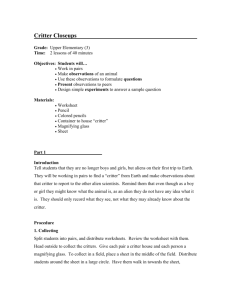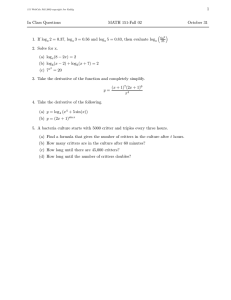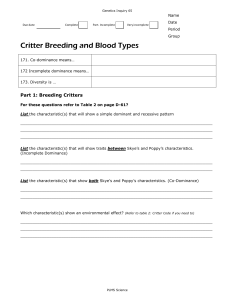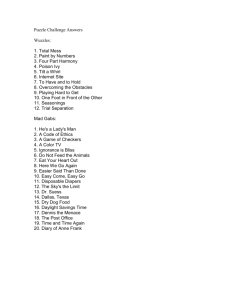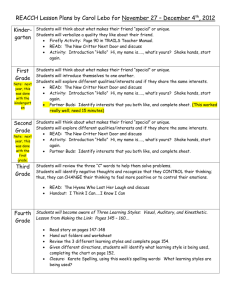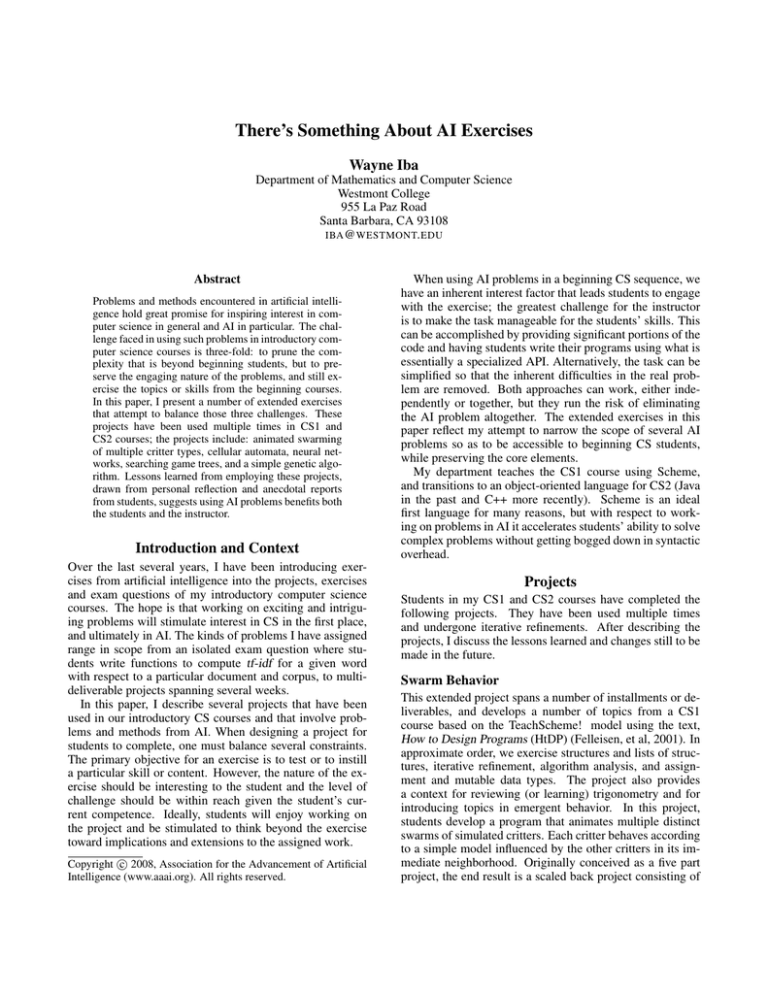
There’s Something About AI Exercises
Wayne Iba
Department of Mathematics and Computer Science
Westmont College
955 La Paz Road
Santa Barbara, CA 93108
IBA @ WESTMONT. EDU
Abstract
Problems and methods encountered in artificial intelligence hold great promise for inspiring interest in computer science in general and AI in particular. The challenge faced in using such problems in introductory computer science courses is three-fold: to prune the complexity that is beyond beginning students, but to preserve the engaging nature of the problems, and still exercise the topics or skills from the beginning courses.
In this paper, I present a number of extended exercises
that attempt to balance those three challenges. These
projects have been used multiple times in CS1 and
CS2 courses; the projects include: animated swarming
of multiple critter types, cellular automata, neural networks, searching game trees, and a simple genetic algorithm. Lessons learned from employing these projects,
drawn from personal reflection and anecdotal reports
from students, suggests using AI problems benefits both
the students and the instructor.
Introduction and Context
Over the last several years, I have been introducing exercises from artificial intelligence into the projects, exercises
and exam questions of my introductory computer science
courses. The hope is that working on exciting and intriguing problems will stimulate interest in CS in the first place,
and ultimately in AI. The kinds of problems I have assigned
range in scope from an isolated exam question where students write functions to compute tf-idf for a given word
with respect to a particular document and corpus, to multideliverable projects spanning several weeks.
In this paper, I describe several projects that have been
used in our introductory CS courses and that involve problems and methods from AI. When designing a project for
students to complete, one must balance several constraints.
The primary objective for an exercise is to test or to instill
a particular skill or content. However, the nature of the exercise should be interesting to the student and the level of
challenge should be within reach given the student’s current competence. Ideally, students will enjoy working on
the project and be stimulated to think beyond the exercise
toward implications and extensions to the assigned work.
c 2008, Association for the Advancement of Artificial
Copyright Intelligence (www.aaai.org). All rights reserved.
When using AI problems in a beginning CS sequence, we
have an inherent interest factor that leads students to engage
with the exercise; the greatest challenge for the instructor
is to make the task manageable for the students’ skills. This
can be accomplished by providing significant portions of the
code and having students write their programs using what is
essentially a specialized API. Alternatively, the task can be
simplified so that the inherent difficulties in the real problem are removed. Both approaches can work, either independently or together, but they run the risk of eliminating
the AI problem altogether. The extended exercises in this
paper reflect my attempt to narrow the scope of several AI
problems so as to be accessible to beginning CS students,
while preserving the core elements.
My department teaches the CS1 course using Scheme,
and transitions to an object-oriented language for CS2 (Java
in the past and C++ more recently). Scheme is an ideal
first language for many reasons, but with respect to working on problems in AI it accelerates students’ ability to solve
complex problems without getting bogged down in syntactic
overhead.
Projects
Students in my CS1 and CS2 courses have completed the
following projects. They have been used multiple times
and undergone iterative refinements. After describing the
projects, I discuss the lessons learned and changes still to be
made in the future.
Swarm Behavior
This extended project spans a number of installments or deliverables, and develops a number of topics from a CS1
course based on the TeachScheme! model using the text,
How to Design Programs (HtDP) (Felleisen, et al, 2001). In
approximate order, we exercise structures and lists of structures, iterative refinement, algorithm analysis, and assignment and mutable data types. The project also provides
a context for reviewing (or learning) trigonometry and for
introducing topics in emergent behavior. In this project,
students develop a program that animates multiple distinct
swarms of simulated critters. Each critter behaves according
to a simple model influenced by the other critters in its immediate neighborhood. Originally conceived as a five part
project, the end result is a scaled back project consisting of
Figure 1: A screen shot of two populations of critter types
swarming with critters of their own type and avoiding the
other type.
four deliverables. The final state of the deliverable specifications are available on the web and sample solutions will be
provided to interested instructors upon request.1 The project
has been implemented on several occasions by the students
in my first semester introductory computer science course.
Figure 1 shows a snapshot during an execution of the solution to the final deliverable.
About the project The project was originally inspired by
a combination of Section 25.1 from HtDP and prior work
simulating flocking “Boids” (Reynolds, 1999, 1987). When
covering generative recursion, I realized that the “Modeling
Balls on a Table” problem could be extended quite nicely
to a critter simulation where instead of moving with a fixed
velocity (dx and dy), the objects could actively steer themselves. From there, it was a straight forward extension to
make the steering adjustments dependent on other critters
in the neighborhood. Finally, a natural extension represents
multiple critter types and collections of critters within a twodimensional grid using vectors and their mutation operators
to improve efficiency. As time allows, the implementation
can be transformed using the the encapsulation techniques to
gain experience with the object-oriented paradigm. I ended
up sequencing the project as four deliverables: modeling a
critter and population of critters and animating them, improving the model of a critter and computing neighbors and
steering adjustments, animating the swarming behavior of a
single population based on the neighbor identification and
steering adjustments, and finally animating two swarms involving a large numbers of critters.
Moving simple critters Apart from simply getting the students started, I had two objectives for the first deliverable
– create a data structure for representing a critter and data
definition for collections of critters, or swarms, and then to
1
This and other project descriptions may be found at my webpage (http://www.westmont.edu/˜iba) under the teaching pages. If you would like to view sample solutions, please contact the author and identify yourself as an instructor.
animate swarms on a canvas. I provided initial definitions
for critters and swarms. The first version of a critter used
a scheme structure consisting of a posn to represent a critter’s location and two numbers for its heading and speed. A
critter’s heading ranged from −π to π. A swarm was simply a list of critters. This worked well to support simple
movement and random maneuvering in terms of heading and
speed. A critter was rendered as a dot and a line-segment
showing the critter’s current heading. The animation of
swarms followed the standard “draw-wait-clear-update” cycle introduced in Section 25.1 of HtDP. The project specifications also required students to implement wrapping from
one side to the other and between top and bottom, so that
when critters moved off the edge they reappeared on the opposite edge.
I intended for the first deliverable to give students additional practice working with structures, lists of structures,
and drawing shapes. In addition, the heading and speed representation required students to use trigonometry and geometric translations to compute updated locations. This motivated thinking about vector operations, which would play
prominent roles in future deliverables. Although we had already introduced Scheme vectors, we used a posn to represent a 2-D vector. The new location of a critter is computed
by adding the current position’s x and y coordinates to the
cosine and sine (respectively) of the heading scaled by the
speed.
As an optional challenge, students could implement the
update function so as to randomly vary the heading and
speed of each critter. In any event, students were expected to
create critters with random locations, headings and speeds,
then package them as a swarm and animate the movement
of the swarm on the canvas.
Neighbors and steering For the second deliverable, students developed the machinery that would enable swarming. To accomplish this, they needed functions for computing neighbors and several steering components based on the
neighbors found. I pointed students toward articles on the
web that contain complete details for these methods (and
many others) (Reynolds, 1999). Here I will only describe
the general nature of these functions. First, a critter will
adjust its direction and speed based on other critters in its
vicinity. Let us consider another critter to be a neighbor if
it is closer than a given fixed distance (radius) and within a
given field-of-view. The first part involved a simple distance
computation but the second required a modified dot product
computation to compute the angle between an agent’s current heading and the direction toward a possible neighbor.
If the computed angle is less than the fixed “field-of-view”
angle and critter is close enough, we call it a neighbor.
After filtering the entire swarm to just those that qualify as neighbors, we need to compute three steering vectors.
One steers a critter in alignment with its neighbors, adjusting both heading and speed toward matching the group’s
average heading and speed. The second tries to maintain
cohesion with neighboring critters by steering a critter toward the center of mass of its neighbors. The third steering
vector maintains separation with the neighboring critters so
that they avoid bumping into each other and clumping excessively. In the next deliverable, these individual steering
adjustments served as weighted components of an overall
steering vector.
This work with computing average headings (needed for
the alignment component) presented an opportunity to reinforce the lessons from Section 16 on iterative refinement.
It is difficult to determine the average heading of a critter’s
neighbors based on the initial representation consisting of
location, heading and speed because average is not well defined within a cyclic system. Thus, I “encouraged” students
to migrate to a critter structure that represented the heading
and speed as a single vector (posn). This alternative representation has several advantages over the initial one, most
notably the avoidance of calling trigonometric functions.
Finally, this deliverable created an opportunity to demonstrate the benefits of utility functions. Students were encouraged to create a collection of utilities such as vector addition, subtraction, distance between vectors, vector scaling,
normalization, and dot product (using posns in each case).
Figure 2: A screen shot of the one-dimensional cellular automata (rule 110) where the top row of the image represents
the environment at the start and successive generations are
rendered below the previous generation.
Swarming and edge avoidance For the third deliverable,
students had to put the pieces from the first two together
so that individual critters would turn, slow and accelerate
in response to actions of their neighboring critters. In addition, students had to develop code that would compute yet
another steering factor, introduced to prevent critters critters from flying off the edge (and wrapping around). The
various individual steering vectors for alignment, cohesion,
and separation, in conjunction with edge avoidance, were
weighted (vector scaling) and combined (vector sum) into a
single steering vector.
At this point, the maximum speed and maximum acceleration fields added to the critter structure definition came
into play. Students needed to “clip” their steering vectors
and resulting velocity vectors according to a critter’s maximum acceleration and maximum speed, respectively. The
steering vector was treated as an acceleration vector and
would be appropriately reduced if its magnitude was greater
than maximum acceleration. Similarly, the new velocity
vector, derived from adding the current velocity and the
(clipped) steering vector, was also reduced if its magnitude
was greater than maximum speed.
dius for determining neighbors, all of a critter’s neighbors
would necessarily be found in a critter’s cell and its immediately adjacent cells. For a 10-by-10 grid, we need only
check nine cells instead of 100. This approach to modeling
the world and processing neighbors gave students practice
working with mutable structures and Scheme vectors.
Finally, I sent students on a general search for efficiency
improvements. I provided a few hints for avoiding repetitive
structure creation and reminded them to avoid expensive duplicate computations, and then suggested they use a timing
wrapper to evaluate the actual benefits derived from candidate improvements.
Multiple critter types and large swarms The final deliverable focused on efficiency issues that arise when dealing with large swarms. First, we introduced critter type and
color fields to the critter structure and required students to
update their program so that critters would swarm with their
own type but would avoid other types. Likewise, critters of
a particular type should be rendered in their specified color.
The biggest efficiency bottleneck encountered in simulating swarm behavior involves determining a critter’s neighbors. As an n2 operation, this was not a problem for swarms
of 10 or 20 critters, but animating 100 critters or more was
out of the question. Thus, I had the students model the world
as a grid (a vector of vectors containing lists of critters),
where each cell of the grid contained only those critters that
were located within the region represented by the grid cell.
By choosing the resolution of the grid according to the ra-
One-dimensional environments In the first deliverable,
the environment consists of a linear sequence of cells, each
of which are either alive or dead. Figure 2 contains a screen
shot that displays a sequence of generations for a row of
cells. The top row of the image in the figure represents the
initial state of the sequence of cells, while each row moving
down the image represents the next generation. For a given
cell with a given state, the next state it will have is defined
by a rule that embodies a function over the current states of
the cell and its neighbors on either side. Thus, three state inputs determine the next state. Extracting the pattern of three
values for a given cell represents one of the basic challenges
for this assignment.
Students do not have much difficulty grasping this basic
notion of conditionally determining the new state based on
three values. However, I have students represent a rule as
Cellular Automata
Implementing cellular automata provides an ideal means to
reinforce list processing and vectors (arrays), and as an introduction to the object paradigm. In addition, I intended
to challenge students’ preexisting assumptions regarding the
nature of life and replicating patterns. The project consists
of three deliverables, following an approximate sequence of
one-dimensional cellular automata, Conway’s Game of Life,
and an object-oriented implementation of the Game of Life.
two deliverables. The first constructs the basic LTUs and
the second assembles them into a full neural networks with
back-propagation.
Figure 3: A screen shot of Conway’s Game of Life.
a number between 0 and 255 inclusive (i.e., an eight-digit
binary number). The nth digit in the binary representation
of the rule number determines the new state for the pattern
described by the binary representation of n.
This scheme for representing the rule is very compact and
clever. Admittedly, it is non-trivial to grasp and indeed the
students have considerable difficulty with it. In future instantiations of this project, I may dispense with this representation, instead using a standard sequence of conditional
tests. However, the numeric rule approach has the nice characteristic that students can easily iterate through all possible
rules without changing any code.
Two-dimensional CAs For their second project deliverable, students implemented a version of Conway’s Game of
Life. Figure 3 shows one particular state of the simulated
environment. First, the game of life forces students to work
with two-dimensional array-like structures and become familiar with row and column indexing. Second, this provides
an entry to programming with objects. I have the students
define a cell class and then populate a grid with instances of
that class.
In the object-oriented version of the CA, cells pass messages to their neighbors (call their methods) to determine the
state of the environment around them. Together with their
own state, each cell then updates its state. Although state
has already been introduced at this point, this also serves to
underscore the nature of state.
Neural Networks
Neural networks represent a natural candidate for an extended exercise from AI. They exercise standard topics covered in the introductory courses and are perhaps the tool
from AI with the widest name recognition among the general population. I used a neural network project in the third
and fourth weeks of my CS2 Data Structures course. The
project reinforces the ideas of classes and objects and introduces interfaces in Java. While covering these basic topics,
I introduced the students to LTUs, back-propagation, decision boundaries, training and testing, and cross-validation.
I have used this project as both a two-part and a three-part
project. Depending on how much other work is required
in parallel with the project, it can most naturally be cast as
Language mechanics and object-oriented practice
When I taught the CS2 course, students had learned to
program with Scheme in CS1 and started using Java in
CS2. Consequently, they needed some extra time to become
familiar with arrays and the Class/Object way of thinking.
The first deliverable requires students to implement a
simple LTU class that supports an interface I provide. The
interface prescribes methods to set the weights and inputs
of an instance; an automated test harness can evaluate code
by setting weights for a particular Boolean function and
checking the LTU’s outputs over all possible sets of inputs.
LTUs at this point simply compute the linear weighted sum.
Building the network from LTU instances For the second part, students must build the fully connected network
and the wrapper code to train and test their project on the
seven-segment LED problem. Again, I provide an interface
that significantly constrains their solution space; in this case,
methods for getting and setting the outputs and inputs respectively, and a method that trains the network. The internal relationships between LTUs in one layer and those in
another are described in the assignment prompt.
After implementing the complete neural network, students must also write the wrapper code that will train the
network’s weights. They must also test their trained network, ultimately reporting an accuracy score. I use this opportunity to demonstrate cross-validation and discuss generalization in this problem domain.
Reflections and Lessons Learned
Creating these projects has been extremely enjoyable for me,
and based on student reactions, they seemed to enjoy completing them. Even though aspects of the projects proved to
be more challenging than I initially estimated, students did
not seem to be discouraged by the difficulties. For example, during the first year I used the swarm behavior project,
some students expressed disappointment when I canceled a
fifth deliverable that was to involve sheep dogs that would
herding sheep. One of the greatest benefits of the two CS1
projects is the way the respective deliverables exercise topics
from the HtDP text in a gradual way. The final deliverable
for both of these dove-tail especially well with the treatment
of side-effects, state and mutable data types. Nevertheless,
these projects can be improved along several dimensions;
these changes revolve around pacing, preparation, and feedback.
Timing and pacing For all of these projects, I have had
to make timing and pacing adjustments after each course. In
the case of the neural network project, I had to delay the start
of the project in order to give students more time to become
familiar with Java. With the other two projects, the deliverables have tended toward the final weeks of the semester,
thereby motivating an earlier start date.
In addition to timing or scheduling, I have had to adjust the pacing of the projects either by repartitioning sub-
tasks between the deliverables or by allowing more time to
complete the more challenging deliverables. In the case of
the swarm behavior project, the second and fourth parts are
more demanding than the others and students benefited from
additional time for those. Depending on the overall strength
of the students in a class, I continue to have to make adjustments.
Student preparation A significant part of the challenge
for some of my students is their lack of mathematical training. For example, the swarm behavior project relies extensively on trigonometry and vector math in order to select
the neighbors and then to determine the various steering adjustments. Similarly, the cellular automata project (as previously given) required a familiarity and comfort with binary
arithmetic. The projects can be more effective and enjoyable for everyone involved when I provide the necessary instruction on either trigonometry and vector algebra for those
students who need it. In addition, increased attention and
focus on the animation exercises prior to the first deliverable
will help students considerably with some of these projects.
I have implemented this change to some extent with some
success; however, the pressures of covering the course material always push back, so this remains an area for seeking
improvement.
Feedback and review For the strong students, these
projects are an enjoyable exercise or diversion. However, the
demands of the deliverables can put the weaker students over
the edge. Even though I provided solutions after the due date
for each deliverable, there was not sufficient time allotted
for some students to digest these solutions. Thus, students
either continued to struggle with their own initial solutions,
or tried to build on the code I provided but without fully understanding it. In the future, I intend to address this problem
on two fronts. From the very beginning of the course, I want
to place much more emphasis on reading code. This could
involve peer-review of homework exercises or perhaps “reverse” exercises where the students must generate specifications in the form of a problem statement or question based
on a given (undocumented) function. The second front of
attack on this consists of spending time reviewing the published solutions; since class time is not available for this, I
have added help sessions for those students who need them.
Recently Completed Projects
In order to prevent students from passing around solutions
to a small number of projects, and for my own stimulation,
I am continually looking for suitable projects with which to
challenge students and hopefully ignite an interest in computer science or AI. In this section, I describe two projects
that were recently completed by students in my CS1 class.
Game Tree Search
In our approach to CS1, I emphasize the way program design follows the data representation that is chosen to model
a problem domain. In particular, we focus on self and mutually referential data types and the program designs that follow from them. However, using the Scheme language, it is
easy to rely so much on lists that the generality of this insight – that function follows form – gets obscured. Thus, a
small project that uses trees provides a contrasting exercise
where students strengthen their ability to reason about selfreferential data types in general and develop programs that
process them.
For this project, I used tic-tac-toe as the basis for the
development of a turn-based adversarial search framework.
Students created a data representation for a game tree, and
then wrote the functions to populate a game tree from a
current state and a player that is to move next. I provided
data definitions for game-states and methods for displaying
a game-state. The project was assigned as a single deliverable.
Students wrote the functions for checking winning positions, a numeric evaluation of a game-state and generating
the collection of possible next game-states from the current
game-state and for a given player to move next. Either as an
additional part to this deliverable or as an in-class group exercise, students will also need to create a representation for
trees of game-states (i.e., a game tree).
Students also had to implement the minimax procedure
that generates the “best” move for a player in a given situation. This involves creating the game tree for the next-player
rooted at the current position and searching within that tree
according to the minimax algorithm.
I had intended to make this a multi-part project and have
students apply their game-search engine to a more complicated game such as Gomoku. As the first project in a first CS
course, it probably makes sense to break it into two deliverables and add a small amount of additional work. Although
we moved on to other projects instead of extending this, the
project motivated one student to explore the topic independently and has since lead to two separate projects in a software engineering course and a machine learning course.
Natural Selection Simulation
As an exercise in processing lists, I had students implement a
variation of Dawkin’s (1986) Weasel program. The problem
involves a simplistic model of natural selection and gives the
students a hint at the potential of genetic and evolutionary algorithms. In this model, letters represent genes and strings
stand for a genetic sequence. Our problem might be stated
as follows: starting with a population of random sequences
of letters, how long will it take for one to converge on a specific target string (e.g., “methinks it is like a weasel”) under
certain mutation conditions and natural selection? Specifically, each letter in a random sequence is mutated according
to certain probabilities; a letter that does not match the target will be likely to mutate, while a letter that matches the
target will be unlikely to mutate. The project consists of five
chunks of work on the part of students. Depending on if this
is given as a first project or later in the semester, it could either be a single deliverable or split into two. In this case, the
students completed the project as two deliverables, the first
consisting of the basic mechanics and the second exercising
their understanding of the MVC through the use of GUIs.
Given the data definitions for genes and gene-sequences,
students had to write several functions that implement the
mutation and selection processes. Focusing on single organisms (a genetic sequence), they needed three functions: one
to generate a random organism, another to generate an offspring from a given individual via mutation, and a third that
computes the fitness of a given individual with respect to the
target.
Having given initial data definitions and guidance on the
functions to be written, students then had to define a data
type for populations of organisms and write functions that
process a population over a number of generations. First,
they were to write the machinery that computes the fitness
over a population and then probabilistically creates a new
generation of offspring; an organism is probabilistically selected (with replacement) to generate an offspring based on
its fitness. Finally, students needed to write the wrapper
code that iterates through generations either until an individual reaches the target or the simulation exceeds a maximum
number of generations.
Conclusions
The projects described above have been quite enjoyable and
have stimulated several students’ interest in artificial intelligence. Most recently, the CS1 course has given rise to a
cluster of students intending to focus in AI and cognitive science. One of those students remarked that the “fun factor”
of the project was challenging his time-management discipline. These exercises engage students in problems that are
interesting and stimulating, with many possible points of departure for future or more advanced projects. The minimax
exercise has spawned two new projects, one of which involves implementing a simple learning algorithm and training the program to play Gomoku.
Beyond the enjoyment, the projects reinforce a nice range
of topics from the introductory sequence in computer science. Also, they introduce these topics in an orderly sequence that mesh quite well with the presentation in the
course structure. When time allows, several of the projects
can be extended to introduce or exercise object-oriented
thinking.
However, the question remains whether or not these extended exercises (or still other projects that involve AI) can
stimulate interest in computer science. It is not too difficult
to imagine survey and tracking methods that would reveal a
boost of interest in CS, if it exists, as a result of AI exercises
in the introductory course sequence. But perhaps a more
informative question would ask what are the characteristics
of any problem that fits well in an introductory course and
motivates interest in CS? That is, what is it about a problem in general that will engage students and draw them into
the discipline? Then we can ask, which AI problems have
that something? While systematic answers are yet to come,
I have observed one consistent phenomenon my introductory courses: my students enjoy themselves and have more
fun the more I am enjoying myself and having fun. Not surprisingly then, students enjoy their work on projects when I
take the time to create assignments that I enjoy. Perhaps that
points us toward the something.
References
Dawkins, R. (1986). The Blind Watchmaker. New York:
Norton & Company, Inc.
Felleisen, M., Findler, R. B., Flatt, M. & Krishnamurthi,
S. (2001). How to Design Programs: An introduction to
computing and programming. MIT Press.
Reynolds, C. W. (1999). Steering behaviors for autonomous characters. (Presented at the 1999 Game Developers Conference.) http://www.red3d.com/cwr/steer/gdc99/
Reynolds, C. W. (1987). Flock, herds, and schools: A
distributed behavioral model. Computer Graphics, 21(4),
pp. 25-34. (ACM SIGGRAPH ’87 Conference Proceedings,
Anaheim, California, July 1987.)

